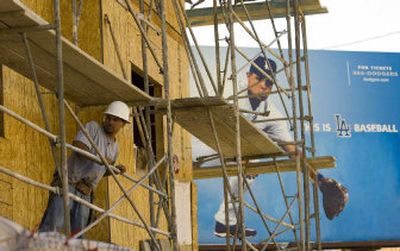Year offered something to build on

Will we miss 2005?
If you dwell on the year’s major news stories, probably not. Natural disasters dominated national and international headlines. The war in Iraq continued, with the outcome not certain. Locally, the recall of Mayor Jim West was the leading story.
Consumers and business flinched at the cost of energy, and raw materials in general. Essentials like cement were, in effect, rationed. While Washington voters were endorsing, against most predictions, a three-year, 9.5 percent gasoline taxes, the Department of Transportation was contending with a 19 percent increase in the cost of construction materials.
Congress, try as it might, cannot seem to balance the federal budget on the backs of the poor and middle class. Foreign governments and investors feed on U.S. debt while all we get is crummy T-shirts.
Yet, overall, things are pretty darn good.
The U.S. economy will probably close the year with growth in the gross domestic product of around four percent. Employment numbers are good. Consumers seem to be recovering their footing now that gasoline prices have receded, at least temporarily.
U.S. employers have hired an additional two million workers in the last year. As of the end of November, Washington has added 75,000 jobs, 5,000 of those in Spokane County. Idaho has also added about 5,000 jobs, and the unemployment rate is below four percent, a level many economists consider full employment. The nation’s and the area’s biggest challenge will be finding and educating the workers that business needs in the 21st century.
If only the improving employment numbers carried over into growth in personal income. During the third quarter, personal income rose .6 percent nationally, but hourly wages actually declined .6 percent after allowing for inflation. Washington, with a stout 1.7 percent jump in personal income, ranked third in the country for the period. Idaho’s .6 percent increase earned the state a low ranking of 48.
Much of the local activity was construction-related. New homes continue to inundate the Spokane Valley and Rathdrum Prairie. Developments like Riverstone are erasing, for better or worse, evidence of the timber industry’s presence along the Spokane River in Coeur d’Alene and Post Falls. The Academic Center on the Riverpoint Campus and Convention Center exhibit hall, though still works in progress, continue the transformation of downtown Spokane’s east end. Work on a new nursing school will sustain that momentum. At the west end, bulldozers are clearing the ground for Kendall Yards, which could remake a wasteland into a crown jewel with homes, stores and restaurants.
And some of the city’s tattered streets are finally getting fresh asphalt, although the recent rash of potholes may have drivers despairing that we will ever catch up with the decay.
Besides construction, the rebound in commercial aircraft orders has restored some of the shine to Kaiser Aluminum Corp.’s Trentwood rolling mill, as well as operations at other aerospace suppliers. High-tech businesses like Itron Inc., and ISR Inc. are thriving in Spokane Valley. Schweitzer Engineering Laboratories cannot seem to expand its Pullman facilities fast enough. The purchase of Itronix Inc. by General Dynamics Corp. has brought one of the nation’s premier technology and defense firms into the area.
On the downside, wi-fi equipment maker Vivato has closed. Scrapping of Kaiser’s Mead plant has extinguished the remote hope the smelter might restart. Agriculture remains under pressure.
The Inland Northwest has done much worse. It has seldom done better.
The outgoing and incoming chairmen of the Spokane Area Chamber of Commerce, neither of whom are natives, wonder at the changes over the last few years.
“This community is riding a very powerful, very productive wave right now,” says Hollister-Stier Laboratories President Tony Bonanzino, who just stepped down at the chamber. “I see it getting better and better over the next five to 10 years.”
His successor, Sacred Heart Medical Center Chief Executive Officer Skip Davis, is no less optimistic.
“I think we’re on the move for a different order of development here in Spokane,” he says.
Back in the late 1980s, momentum was just a hope for Spokane. It’s a reality now. Miss 2005? Only if we stumble.
Happy 2006.